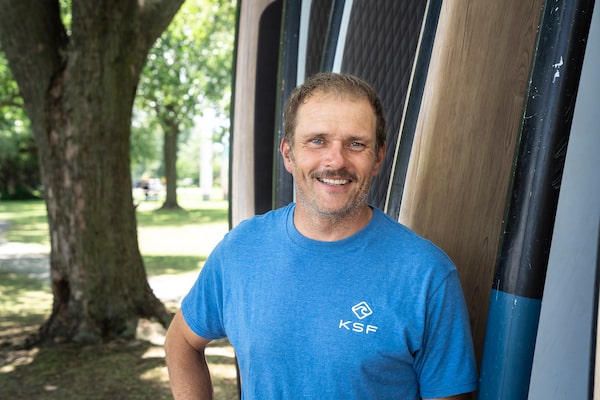
Hugo Lavictoire, founder of KSF, a Montreal-based company that rents, sells, and provides instruction in kayaking, stand-up paddle-boarding, and surfing, says demand is up by about 75 per cent over the pandemic.Josie Demarais/The Globe and Mail
Shortly after Shams Ben Temessek moved from Montreal to Vancouver in the summer of 2021, she met a friend that loved sea kayaking. The sport intrigued her. “It’s a great way to travel, look at the landscape and be outside,” she says. “The level of skill [necessary] is not super high. Sea kayaking is more about leisure, being mindful and enjoying yourself.”
Ms. Ben Temessek signed up for a three-hour introduction course at Jericho Beach Kayak. “After that course, I could kayak on my own,” she says. “I would rent a kayak and kayak alone to practice my skills and enjoy the day.”
Since then, Ms. Ben Temessek has taken an instructor course so she can teach others how to kayak. She has also organized community paddling meetups, like a monthly BIPOC paddle over the summer, to get more people involved in the sport.
“It’s often people who just moved to Vancouver,” she says of beginner paddlers. “They’re looking to explore the city and do something during the weekends or evenings.”
Ms. Ben Temessek is just one of many Canadians who have recently taken up a new hobby in watersports. Hugo Lavictoire, founder of KSF, a Montreal-based company that rents, sells, and provides instruction in kayaking, stand-up paddle-boarding, and surfing, says that demand for his business increased by about 75 per cent over the pandemic.
“We were crazy, crazy busy for the past two years,” says Mr. Lavictoire. “People were stuck in Montreal and were not able to travel. But they had a budget for vacation and wanted to do something outside.”
Over the pandemic, Mr. Lavictoire saw more people from diverse backgrounds and families trying watersports for the first time. For those new to water sports, Mr. Lavictoire says that stand-up paddle-boarding is a popular choice.
“Compared to a kayak, you’re not stuck in it,” he says. “You feel a lot safer because if you fall off your board, it’s really easy to get back on it. When you’re standing on the board, you can see much further and deeper, so the view is better compared to kayaking, where you sit really close to the waterline.”
Jay Taylor, chief operating officer of the outdoor gear retailer MEC, saw a 25 to 30-per-cent jump in the sales of kayaks, canoes, and stand-up paddleboards during the pandemic, along with a 45 to 50-per-cent increase in accessories like personal flotation devices.
Equipment sales have stabilized this year, but Mr. Taylor believes that those who were first introduced to watersports over the pandemic will continue to discover new ways to use them, like stand-up paddleboard camping.
“It’ll become a new way to travel inside the country,” says Mr. Taylor. He also says the sale of accessories at MEC, like dry bags, is still strong. “That’s a good indicator for us that people are making an effort to continue to participate in the sport.”
Operators can also find increasingly creative ways to engage new and seasoned water sports enthusiasts. In Montreal, KSF offers lessons in stand-up paddleboard (SUP) yoga and SUP fitness classes.
Inflatable equipment can also make watersports more accessible for casual paddlers. The popularity of inflatable stand-up paddleboards and inflatable kayaks was increasing even prior to the pandemic, and Mr. Taylor believes that interest will continue to be robust. “They’re portable and easy to store,” he says. “We see it a lot in Vancouver, where they’re jumping on the bus with an inflatable SUP, they get to the beach, pump it up and away they go. It’s more convenient than trying to find parking these days.”
The peak season for watersports is typically quite short in Canada – just a few months long, but Mr. Lavictoire says that he’s seeing more and more watersport enthusiasts in Montreal donning wetsuits to extend their season.
“You can enjoy watersports for almost 10 months of the year, even in November, when the lakes are not frozen and you have a good wetsuit,” he says. “You can start early as March or April. It makes your season a bit longer, with good equipment.”